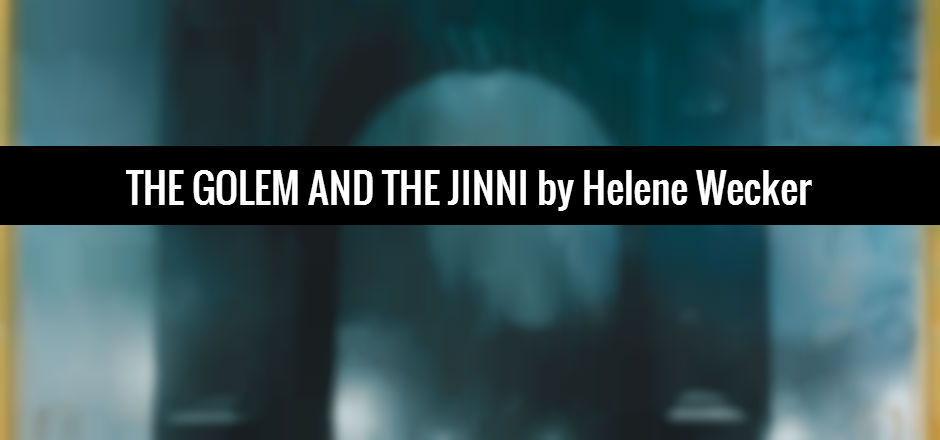The Golem and the Jinni is Helene Wecker’s debut novel. I’m putting that out there right away because I’m still trying to absorb it myself. Debut novel? Seriously? Damn, girl.
The novel tells the story of… well, of the Golem, created by Yehudah Schaalman, a corrupt Kabbalistic rabbi in Poland to serve as another man’s obedient and perfect wife. The man takes his supernatural bride across the seas in a ship sailing to America, but in a twist of fate, she winds up on Manhattan soil without her master at her side. It also tells the story of the Jinni, a creature of fire bottled up and trapped in a flask for thousands of years, finally freed in a tinsmith’s shop in the Little Syria area of New York. Of course, despite their many differences, these two are destined to meet.
 There’s a lot more going on in this novel, but those are the bare bones, and subsequently the most important ones. The parallels between the Golem and the Jinni, and the way they really are opposites of each other, make their interactions and their conversations all the more intriguing. The Golem is a creature made to be submissive to a master, yet she’s essentially free of her chains and doesn’t know what to do with her freedom; she’d feel more comfortable being of help to someone. The Jinni is a creature made to be free, able to transform his physical appearance at will and do whatever he pleases, yet he’s been chained to a human form and enslaved by a powerful wizard; he doesn’t understand how the Golem could want anything but freedom.
There’s a lot more going on in this novel, but those are the bare bones, and subsequently the most important ones. The parallels between the Golem and the Jinni, and the way they really are opposites of each other, make their interactions and their conversations all the more intriguing. The Golem is a creature made to be submissive to a master, yet she’s essentially free of her chains and doesn’t know what to do with her freedom; she’d feel more comfortable being of help to someone. The Jinni is a creature made to be free, able to transform his physical appearance at will and do whatever he pleases, yet he’s been chained to a human form and enslaved by a powerful wizard; he doesn’t understand how the Golem could want anything but freedom.
It’s this contrast that drives both of their plots forward, even before they meet each other on the pages. The Golem finds work in a Jewish bakery and, although it’s not the same thing as having a master, she enjoys helping people feed their families and serving a bigger purpose than her own needs. Similarly, the Jinni begins working for Boutros Arbeely, the tinsmith that found and freed him from the flask, but begins to somewhat resent the monotony and confinements of the tin shop and yearns for the freedom to explore New York the way he wants to. The Jinni’s explorations and the Golem’s desire to help others define them but also cause them problems along the way.
The novel is a long one, but you eventually forgive the length because Wecker uses her words to weave together a New York circa 1899 that feels both very real and very otherworldly, given the supernatural inhabitants trying to blend in amongst their fellow man. There’s a lot of folklore, myth, and history in The Golem and the Jinni, and most, if not all, of it serves to enrich the characters and their backstories. What seems like superfluous information eventually becomes more intriguing and important as the story progresses; the secondary characters whose importance you can’t quite understand eventually make themselves apparent later on.
There are little details, too, that leave an impression on you, whether you expect them to or not. One that stood out for me was when a character came through on Ellis Island and the Bureau of Immigration officer at the desk is asking him all the routine questions. When they arrive at the character’s name, the officer says, “Let’s call you something more American. It’s for the best.” And of course, that was a thing that really happened in history: real people had their names ‘Americanized’ so they can better assimilate into society.
But the irony of the event, and the fact that assimilation is a theme of the novel, with both creatures trying their best to blend in, really left an impression on me. Not only to the Golem and the Jinni have to hide and relinquish their natural selves, but how many of their human peers have had to give up their identities and their names for the sake of fitting in as well? Everyone in this book, whether supernatural or not, faces the problem of trying to make a living for themselves in an unfamiliar city.
There are, admittedly, a few backstories that go on for too long, and so the pacing begins to drag towards a good chunk of the middle of the novel. They’re ultimately important to the plot, so I can’t with good reason say they’re unnecessary, but the amount of time spent explaining certain things – for example, the Jinni’s history with a girl named Fadwa – made the novel drag on and feel weighted down by the sheer amount of information that Wecker needs to get across to us readers. Again, though, it’d be detrimental to the novel as a whole to cut it short or remove entire passages, so in the end you just have to trust me that it’s worth it.
There’s a lot more going on in The Golem and the Jinni but to talk about it in detail would ruin a lot of the magic (pun partially intended). Wecker’s debut novel is rich in detail, history, and folklore, and the characters really start to leap off the page the more you read about them. If you’re a fan of historical fantasy/fiction, or you’re just looking for something fresh and new, trust me, you’ll want to pluck this off the bookshelf.
4.5 out of 5 stars
—
Gabby Taub, the Fantasy Reviewer at Girls in Capes, is a recent graduate of New York University. She enjoys reading, writing, watching TV, and spending time getting lost among the bookshelves at Strand Bookstore.
You may also be interested in checking out Gabby’s review of The Song of Achilles. If you’re more of a fantasy bent, check out The Falcon Throne and A Crown for Cold Silver.






